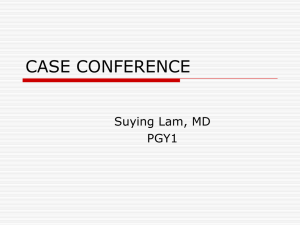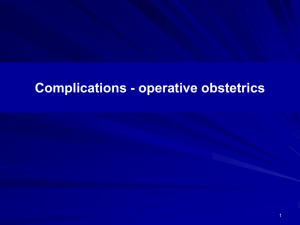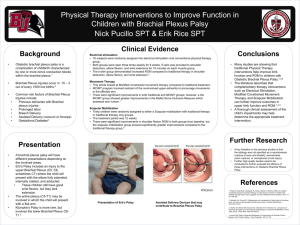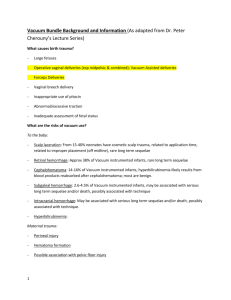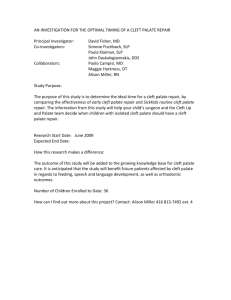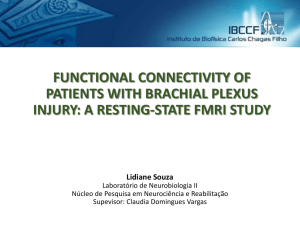The relationship between NICU & OB – birth injury
advertisement
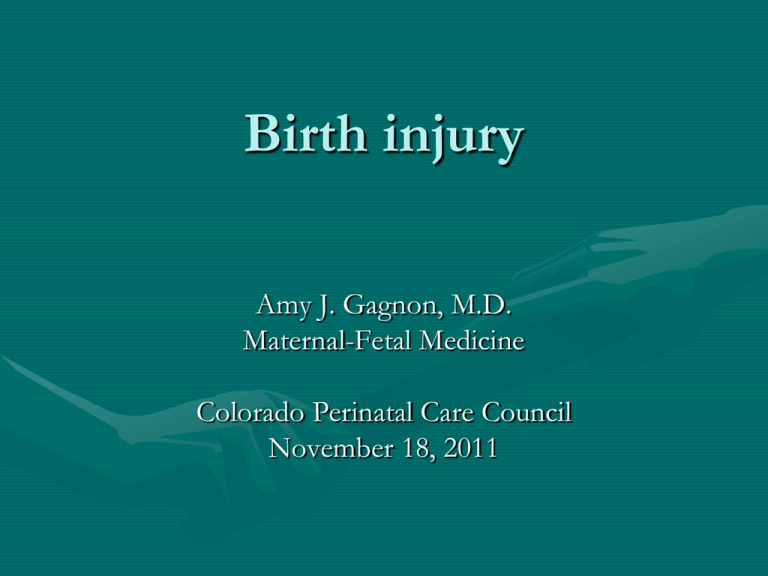
Birth injury Amy J. Gagnon, M.D. Maternal-Fetal Medicine Colorado Perinatal Care Council November 18, 2011 Birth injury: overview • • • • • • Cephalohematoma Subgaleal hemorrhage Retinal hemorrhage Facial nerve palsy Fracture Hypoxic injury Operative vaginal delivery • 1997 U.S. rate operative vaginal delivery: 9.4% • 2007 U.S. rate operative vaginal delivery: 4.3% • Indications – Prolonged second stage: • Nulliparous women: lack of continuing progress for 3 hours with regional anesthesia, or 2 hours without regional anesthesia • Multiparous women: lack of continuing progress for 2 hours with regional anesthesia, or 1 hour without regional anesthesia – Suspicion of immediate or potential fetal compromise. – Shortening of the second stage for maternal benefit. ACOG Practice Bulletin. Number 18, June 2000. Martin et al. National Center for Health Statistics; 2010. Operative vaginal delivery • Cochrane review (Issue 2, 1999) – Use of vacuum associated with much less maternal trauma – Vacuum associated with an increase in neonatal retinal hemorrhages and cephalohematoma • Retinal hemorrhages: twofold higher risk with vacuum versus forceps; data on the long-term consequences of these hemorrhages fails to demonstrate any significant effect • Some studies reveal neonates delivered by VAVD more likely to be readmitted with jaundice Carmody F, et al. Acta Obstet Gynecol Scand 1986;65:763-766 Vacuum versus Forceps • Vacuum • Easier to apply?? • Slower delivery • Increase risk scalp trauma/intracranial trauma • Higher chance failure • Not recommend <3436wks Gei & Pacheco. Obstet Gynecol Clin N Am. 2011; 38:323-49. Williams. Clin Perinatol. 1995;22:933-52. Schaal et al. J Gynecol Obstet Biol Reprod. 2008;37:S231-43 Lurie et al. Arch Gynecol Obtet. 2006;274(1):34-6. • Forceps • More difficult to apply? • Faster delivery • Increased maternal soft tissue trauma • Requires better analgesia • Any gestational age Vacuum versus Forceps • • • • • Particular indication for procedure Anesthesia Availability of instruments Training/experience of physician Patient preference Vacuum-assisted vaginal delivery • Prospective observational study of 134 VAVD. – 28 infants (21%) with scalp trauma. • 17 superficial lacerations; none required sutures. • 6 with large caput succedaneum. • 12 cephalohematomas. • 1 infant with subgaleal, subdural, and subarachnoid hemorrhage. (This infant did not become anemic or hypotensive.) Logistic regression analysis showed duration of vacuum application to be the best predictor of scalp injury (duration 0.5 to 26 minutes, with a median length of 3 minutes) Teng & Sayre. Obstet Gynecol. 1997 Feb;89(2):281-5 Cephalohematoma • Bridging vein ruptures between the outer skull table and the periosteum of the parietal bone • The periosteum is circumferentially anchored to the edges of the parietal bone. Usually a selflimited lesion. • Rates: – Vacuum: 112/1,000 – Forceps: 63/1,000 – SVD: 17/1,000 Cephalohematoma • Secondary analysis of 322 infants randomized to be delivered by vacuum. • Logistic regression identified three factors associated with clinically diagnosed cephalohematoma. – Time required for delivery. – Increasing asynclitism. – Station at application •Bofill et al., J Repro Med 1997;42:565-9. Vacuum time and cephalohematoma 35 33 30 % Cephalohematoma 25 25 21 20 15 15 10 5 6 6 1 min 2 min 8 0 3 min Bofill et al., J Repro Med 1997;42:565-9. 4 min 5 min 6 min 7 min Subgaleal hemorrhage • Blood collects in the loose areolar tissue in space between the galea aponeurotica and periosteum. • The subgaleal space has potential area of several hundred milliliters (can contain the entire blood volume of the neonate.) Bounded laterally by the zygomatic arches, anteriorly by the orbital ridges, and posteriorly by the nape of the neck. Subgaleal hemorrhage • Incidence: – 4/10,000 SVD – 26-45/1,000 VAVD ** Occurs almost exclusively with the vacuum device. • Led to FDA issuing a “public health advisory” regarding the use of vacuum-assisted delivery devices in May 1998 – Cited fivefold increase in rate of deaths and serious morbidity during previous 4 years when compared to previous 11 years FDA Public health advisory regarding vacuum-assisted delivery devices • Persons should be versed in their use and aware of indications, contraindications, precautions as supported in accepted literature & current device labeling • Apply steady traction in line of birth canal. No rocking or applying torque. • Notify pediatricians • Educate neonatal care staff re: complications of VAVD • Report reactions associated with use to FDA Forceps-assisted delivery • Nationally, decrease in experienced teachers/training • Facial nerve palsy: – 5-year period at Brigham and Women's Hospital • 81 cases of acquired facial-nerve palsy (44,292 deliveries) incidence of 1.8 per 1000 • 74 of the 81 (91 percent) associated with forceps delivery • FAVD, birth weight >3500gm, and primiparity all significant risk factors for acquired facial palsy • Recovery complete for 59 patients (89%) and incomplete for the remaining 7 (mean follow-up 34 months) Falco NA and Eriksson E. Plast Reconstr Surg. 1990 Jan;85(1):1-4 Sequential use of vacuum & forceps Sequential use increases liklihood of adverse outcomes more than the sum of the relative risks of each individual instrument ↔ X Operative vaginal delivery: Long term sequalae? • 1993 Kaiser (Oakland): 1,192 FAVD vs. 1,499 SVD – no difference in IQ at 5 years • 10-year matched follow-up evaluation of 295 children delivered by VAVD vs. 302 controls (SVD) revealed no differences between the two groups in terms of scholastic performance, speech, ability of self-care, or neurologic abnormality ** Does not appear to be any long-term effect of operative vaginal delivery on cognitive development Wesley BD, et al. Am J Obstet Gynecol 1993;169:1091-1095 Ngan HY, et al. Aust N Z J Obstet Gynaecol 1990;30:111-114 “Failure” “In cases of operative vaginal delivery, a true failure is not when a vaginal delivery is not accomplished but when a preventable injury is inflicted” Lowe B. Br J Obstet Gynaecol 1987;94:60-6. Shoulder dystocia • Incidence 0.3 – 2% of deliveries • Lack of uniform definition – ACOG: additional obstetric maneuvers following failure of gentle downward traction on the fetal head to effect delivery of the shoulders – prolonged head-to-body delivery time (eg, more than 60 seconds) • Risk factors – – – – – – – macrosomia and fetal anthropometric variations maternal diabetes and obesity operative vaginal delivery precipitous delivery and prolonged second stage of labor history of shoulder dystocia or macrosomic fetus postterm pregnancy advanced maternal age Brachial plexus injury • C4: phrenic nerve palsy • C5-C6 +/-C7: Erb’s or Erb-Duchenne palsy (80% of brachial plexus injuries) • C8-T1: Klumpke’s palsy • C5-T1: Complete brachial plexus injury, or ErbKlumpke palsy Erb-Duchenne palsy (C5-C6 +/- C7) • Classic posture result of paralysis/weakness in shoulder muscles, elbow flexors, & forearm supinators. • Affected arm hangs & is internally rotated, extended, and pronated • Oftentimes, C7 also involved causing loss of innervation to the forearm, wrist, and finger extensors. • The loss of extension causes the wrist to flex and the fingers to curl up in the ‘‘waiter’s tip’’ position. Erb-Duchenne palsy (C5-C6 +/- C7) • Obstetrical literature: – <10% permanent – Persistent injury more common with BW > 4500 g and infants of diabetic mothers • Pediatric/orthopedic literature: – permanent injury in up to 15% to 25% of cases Klumpke’s palsy: C8-T1 • Weakness of triceps, forearm pronators, & wrist flexors leading to a ‘‘clawlike’’ paralyzed hand with good elbow and shoulder function. • Upper-arm function differentiates Klumpke’s palsy from Erb’s palsy. • Only 40% of Klumpke’s palsies resolve by 1 year of life • Associated Horner’s syndrome with sensory deficits on the affected side, contraction of the pupil, and ptosis of the eyelid is caused by cervical sympathetic nerve injury. Brachial plexus injury: ? Birth injury • 34%–47% brachial plexus injuries not associated with SD • 4% occur after cesarean birth • Other causes of injury: – normal forces of labor and delivery (symphysis against the brachial plexus) – abnormal intrauterine pressures arising from uterine anomalies (anterior lower uterine segment leiomyoma, septum, or a bicornuate uterus) • Performance of electromyeolography within 24–48 hours of delivery can help determine the timing of brachial plexus injury – Electromyelographic evidence of muscular denervation normally requires 10 to 14 days to develop – Its finding in the early neonatal period strongly suggests an insult predating delivery Koenigsberger MR. Ann Neurol 1980;8:228. Mancias P, et al. Muscle Nerve 1994;17:1237–8. Peterson GW, et al. Muscle Nerve 1995;18:1031. Brachial plexus injury • No matter the cause, care should involve a multidisciplinary approach including pediatrics, pediatric neurology, physical therapy, and possible referral to a brachial pleuxus injury center. Fracture • Majority involve clavicle – Often occurs in the absence of shoulder dystocia – Incidence at the time of SD ranges from 3-9.5% – Increasing risk with greater birth weight • Humerus most common long bone fracture • Almost invariably heal with simple supportive therapy & do not lead to permanent disability Hypoxic injury • Essential criteria (must meet all four) – Evidence of a metabolic acidosis in fetal umbilical cord arterial blood obtained at delivery (pH <7 and base deficit =12 mmol/L) – Early onset of severe or moderate neonatal encephalopathy in infants born at 34 or more weeks of gestation – Cerebral palsy of the spastic quadriplegic or dyskinetic type – Exclusion of other identifiable etiologies such as trauma, coagulation disorders, infectious conditions, or genetic disorders Hypoxic injury • Criteria that collectively suggest an intrapartum timing (within close proximity to labor and delivery, eg, 0-48 hours) but are nonspecific to asphyxial insults – A sentinel (signal) hypoxic event occurring immediately before or during labor – A sudden and sustained fetal bradycardia or the absence of fetal heart rate variability in the presence of persistent late, or variable decelerations, usually after a hypoxic sentinel event when the pattern was previously normal – Apgar scores of 0-3 beyond 5 minutes – Onset of multisystem involvement within 72 hours of birth – Early imaging study showing evidence of acute nonfocal cerebral abnormality Teamwork! • >60% obstetric medical negligence claims relate to events alleged to occur during L&D • >80% damages awarded • Soon after delivery, discussion with the patient and family (complete, immediate, accurate information) • Events of the delivery must be documented by all careteam members involved • Communicate! ***If a any sort of injury is present, the clinician should NOT speculate regarding the cause Additional References • Martin JA, Hamilton BE, Sutton PD, et al. Final data for 2007. National vital statistics reports, vol 58. Hyattsville (MD): National Center for Health Statistics; 2010. • ACOG. Professional liability and risk management: an essential guide for obstetrician-gynecologists. 2005. • Gabbe, 5th edition. • Gottlieb, AG & Galan HL. Shoulder dystocia: An update. Obstet Gynecol Clin N Am. 34 (2007) 501–531 Questions/comments
